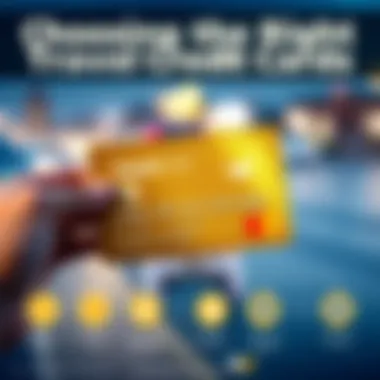Maximizing Cash Back on Travel Credit Cards


Intro
Understanding the world of travel credit cards can be quite a maze, particularly with the lure of cash back rewards. Young professionals, students, and small business owners are often on the lookout for effective financial tools that not only cover travel expenses but also offer significant benefits. In this age of global connectivity, having a travel credit card that provides cash back can transform the way one experiences travel—turning costs into opportunities. This guide aims to demystify how cash back works, the ins and outs of selecting the right credit card, and how to fully take advantage of rewards.
Understanding Financial Concepts
To dive deeper into cash back rewards, it's essential first to understand some key financial terms and concepts. A solid grasp of these ideas can empower individuals to make better financial decisions and educate them on optimally using travel cards.
Definitions of Key Terms
Before jumping into cash back rewards, let’s clarify some terms:
- Cash Back: The percentage of money returned to the cardholder from purchases. It usually ranges from 1% to 5% and can vary based on the type of spending.
- APR (Annual Percentage Rate): The yearly interest rate charged on borrowed money or credit card balances. Keeping an eye on this is vital as high APRs can eat away at any benefits you gain from cash back.
- Redemption: The process by which you use accumulated cash back rewards. This might come as a statement credit, deposit, or other forms.
Understanding these terminologies clears the fog around how cash back operates, thus enabling smarter use of credit cards in travel contexts.
Importance of Financial Literacy
Financial literacy plays a crucial role in maximizing the benefits of travel credit cards. It’s not just about knowing how to choose a card but understanding how to manage your finances in a way that syncs well with your travel goals. Research shows that financially literate individuals are more likely to navigate credit wisely. Here are some points emphasizing its importance:
- Financial literacy can help avoid high debt accumulation, especially in travel scenarios where overspending is tempting.
- A well-informed traveler can identify offers that actually provide good deals rather than falling for marketing fluff.
- Savvy financial skills cut down on reliance on credit, allowing for healthier spending habits overall.
"The best way to predict your future is to create it."
— Abraham Lincoln
Creating a Personal Budget
Having a personal budget is a foundational step for anyone planning to embark on travel adventures. It acts like a roadmap, guiding spending decisions and helping track whether or not one is on track to meet financial goals.
Setting Financial Goals
For all intents and purposes, taking the time to set financial goals is vital.
- Identify short-term (e.g. a weekend getaway) and long-term (e.g. international holiday) travel aspirations.
- Allocate budgets based on these goals while factoring in the potential rewards from your travel credit card.
- Understand what you’re willing to spend to achieve these goals. Are you aiming for luxury, or are you more into budget traveling?
Tracking Income and Expenses
Monitoring income and expenses can unveil surprising insights into your financial habits. Keeping track of
- Regular income (salaries, side jobs)
- Fixed expenses (bills, rents)
- Variable expenses (entertainment, dining, travel)
These observations reveal how much you can comfortably allocate to travel and cash back opportunities. Use spreadsheets, apps, or notepads—whatever gets the job done. The objective is to keep it simple and consistent.
Ultimately, understanding the mechanics behind cash back, setting personal budgets, and being financially literate forms the backbone of maximizing the advantages travel credit cards can provide.
Prelims to Cash Back Travel Cards
Navigating the world of credit cards can feel akin to wandering through a labyrinth, with each turn presenting new options and incentives. Cash back travel cards stand out as intriguing tools for young professionals, students, and small business owners seeking to maximize their spending, especially when it comes to travel. These cards offer a pathway to earning rewards, not by merely accumulating points but by translating everyday purchases into tangible cash back. This section delves into the essence of cash back rewards and traces the evolution of travel credit cards, shedding light on their growing importance in financial decision-making.
Defining Cash Back Rewards
Cash back rewards function as a straightforward concept—credit cardholders earn a percentage of their spending returned to them in cash. Unlike travel points or miles that can sometimes feel like a riddle wrapped in a mystery, cash back provides immediate gratification. Imagine spending on gas, groceries, or entertainment; with a cash back card, you receive a small kickback, which can be a boon for budget-conscious travelers.
This financial incentive has taken root in various card offerings. Typically, the cash back rate can fluctuate based on spending categories—higher returns for travel-related expenses and standard rates for everyday purchases. For instance, consider a scenario where someone shops at a grocery store or fills up their car. With a solid cash back travel card, they might see a percentage of that spending reflected in their account, serving as a little buffer to offset upcoming travel costs. To put it succinctly, cash back rewards make each dollar spent work harder for you.
Evolution of Travel Credit Cards
The landscape of travel credit cards has evolved significantly over the years, mirroring changes in consumer behavior and technological advancements. Gone are the days when your credit card was used solely as a tool for immediate purchases. Today, these cards have morphed into multifaceted instruments designed to enhance the travel experience considerably. Perhaps one of the most notable transformations has been the emergence of lucrative cash back options combined with travel perks.
In the earlier years, most travel credit offerings focused almost exclusively on mileage and points. For example, travelers often needed to navigate complex point systems just to book a flight or hotel. However, as consumer demand for simplicity flourished, many companies began integrating cash back rewards into their travel credit cards.
"This shift towards cash back reflects a broader understanding of consumer preferences and the desire for clarity in reward systems."
Moreover, the ongoing competition in the credit card market has led to the introduction of features such as no annual fees and flexible redemption options. This evolution isn't just about attracting consumers; it's also about meeting the need for transparency and usability in financial products. As these cards have progressed, so too has the accessibility of rewards, allowing cardholders to reclaim parts of their spending without hefty convolutions. Ultimately, the evolution of cash back travel cards signals a revolution in how we perceive and utilize credit cards for travel funding.
How Travel Cash Back Programs Function
Understanding how cash back programs operate is essential for anyone looking to maximize their travel experiences while also keeping their finances in check. Cash back travel cards are designed not only to reward spending but also to serve as a strategic financial tool. They can ultimately enhance one’s overall travel enjoyment.
Understanding Reward Structures
The foundation of any cash back travel card lies in its reward structure. Typically, these cards offer a percentage back on every purchase, with varying rates depending on the category of spending. For instance, you might see a higher cash back rate for travel-related expenses like hotels and flights, while general dining and retail purchases may earn a lower percentage.


Some cards even introduce bonus categories that rotate quarterly, incentivizing users to shop in specific sectors like groceries or gas at particular times of the year. This layered approach ensures that cardholders can tailor their spending to maximize rewards.
To illustrate, let’s imagine a user who spends predominantly on dining out and traveling. If their card offers 3% cash back on travel expenses and 2% on restaurants, focusing their spending in those categories can significantly enhance their cash back earnings. Understanding these structures is crucial, as it allows cardholders to make informed decisions that directly impact how much cash back they can earn.
Calculating Cash Back Earnings
Calculating cash back earnings isn’t simply a plug-and-play situation; it involves keeping tabs on your spending habits and applying the right multipliers. The math can seem a bit daunting but breaking it down makes it manageable.
For example, if a traveler has a card that offers 2% cash back and they spend $2,000 on travel expenses, they can expect to earn $40 cash back from that particular purchase.
A useful way to estimate potential earnings is:
- Total eligible spending = Amount spent in cash-back categories
- Cash back rate = Percentage offered by the card
- Estimated cash back earnings = Total eligible spending * Cash back rate
So, in simpler terms:
- If you spend $600 on travel this month with a 2% cash back card, your cash back would be $12.
Understanding how to project these earnings based on both average monthly spending and promotional offers can help users assess which card aligns best with their financial goals.
Redemption Options for Cash Back
Upon accruing cash back, the next step is figuring out how best to redeem these rewards. Options can vary significantly among different cards and can play a pivotal role in determining the overall value.
- Direct deposit into a bank account: Some cards allow you to transfer your cash back directly into a linked bank account, providing immediate liquidity.
- Statement credit: Another common option is to apply cash back toward your statement balance, which reduces your outstanding debt.
- Gift cards: Many cards offer a variety of gift cards as a redemption option, often featuring popular retailers or travel partners. Keep in mind, though, that the value of cash back when exchanged for gift cards might not be equivalent to its cash value.
- Travel purchases: Some travel cards permit using cash back to fund travel bookings directly, which can sometimes even result in bonus redemption rates.
Ultimately, each option presents unique benefits and potential drawbacks. While one might prefer liquid cash, another might find value in travel credits, especially if they frequently engage in travel reservations. Understanding and optimizing these alternatives accordingly can significantly boost how effectively you use your rewards.
"Maximizing cash back rewards isn't about being a spendthrift; it's about being a strategic spender. 🌍🤑"
In a nutshell, grasping how cash back programs function, from understanding reward structures to calculating cash back earnings and knowing redemption avenues, prepares anyone to utilize these financial tools to their maximum potential.
Key Benefits of Using Cash Back Travel Cards
Travel credit cards that offer cash back rewards can provide substantial advantages for travelers. These benefits not only enhance your travel experience but can also contribute significantly to your financial well-being. Understanding these key benefits can help users make informed decisions about which card suits their lifestyle and spending habits.
Boosting Travel Savings
Using a cash back travel card can lead to considerable savings over time. Each time a user swipes the card, they earn a percentage of their spending back. For instance, if a traveler books a flight for $500 and their card offers 2% cash back, they earn $10 back. While $10 may not seem like a fortune at first glance, these amounts can add up quickly—especially for frequent travelers. Here’s how these savings can be maximized:
- Routine Expenses: By using a cash back card for everyday purchases, users can accumulate rewards to offset travel costs. Groceries, gas, and dining can easily account for a significant portion of spending.
- Monthly Bills: Don’t just think travel—make it a habit to pay monthly bills with the card, as long as there are no fees that could negate the rewards earned.
Generally, the more a traveler engages with their cash back card, the more they will benefit from using it, making it a practical choice for enhancing travel savings.
Flexible Redemption Choices
Cash back travel cards often provide various redemption options, allowing users to tailor their choices to fit their needs. While some might prefer direct cash deposits, others might lean toward travel-related perks. Options typically include:
- Statement Credits: Users can apply their rewards as a statement credit to offset existing charges.
- Travel Expenses: Many cards allow redemption for flights, hotel bookings, or other travel expenses, sometimes even at a better rate than standard cash back.
- Gift Cards or Merchandise: For those who may not travel frequently, converting rewards into gift cards can represent a versatile means of utilizing cash back.
This flexibility means that cash back rewards do not simply disappear into thin air; instead, they can adapt to an individual's spending patterns and needs.
Supplementing Travel Insurance
Many cash back travel credit cards offer supplementary travel insurance, providing peace of mind ahead of a trip. This often includes:
- Trip Cancellation Insurance: If an unforeseen circumstance arises that requires a user to cancel their trip, coverage can lessen financial losses.
- Lost Luggage Protection: In cases where luggage may go missing, this additional benefit can cover the costs incurred.
- Emergency Medical Insurance: For travelers venturing abroad, having access to medical coverage can be invaluable and offers added security during the journey.
Traveling, while exhilarating, comes with its share of uncertainties. When the unexpected happens, knowing that you have a safety net in place allows one to focus on enjoying the adventure.
"Cash back travel cards not only enhance financial rewards but also offer security features that can be vital while navigating the uncertainties of travel."
Arming oneself with such knowledge enables informed decisions when selecting a travel credit card, ultimately leading to smarter financial choices.
Navigating the Selection Process
Choosing the right travel credit card can feel a bit like finding a needle in a haystack, particularly with the dizzying array of options on the market. However, this process is fundamentally crucial in maximizing the value of cash back rewards. Understanding how your personal travel habits intersect with the various card offerings can lead not only to better financial decisions but also to enhanced travel experiences.
Assessing Personal Travel Patterns
Every traveler is unique. Some might jet off to far-flung destinations every few months, while others could be more of the weekend get-away type, seeking solace in the nearest beach or mountain. Nor should we forget the business travelers, who might mix work with pleasure. Identifying these patterns is vital; it guides you in selecting a card that aligns with your spending behaviors—ensuring that every dollar earns its worth.
- Frequency of Travel: If you find yourself traveling several times a year, a card that offers higher cash back rates or bonus points on travel-related purchases could be particularly beneficial. However, if your trips are few and far between, you might lean towards a card with better rewards on general spending categories.
- Spending Categories: Understanding where you spend the most is a game changer. Some cards have rotating bonus categories or more favorable rates on dining, groceries, or gas. If you're beyond the grind of everyday expenses and often dine out or fill your tank for those trips, prioritize those card offerings.
- Destination Considerations: What’s the point of having great rewards if they don’t apply to your preferred travel destinations? Some cards might limit their cash back benefits based on specific airlines or travel agencies. Look for flexibility in airline partnerships, hotel chains, or even travel platform options.


By taking the time to assess these personal travel patterns, you're not just making a choice; you're crafting a strategy that caters to your unique travel needs. This tailored approach can make all the difference in how your cash back unfolds over time.
Analyzing Fees and Interest Rates
It’s easy to get swept up in the allure of cash back percentages or shiny perks without paying necessary attention to the finer details—the fees and interest rates that can quietly nibble away at your rewards. A card that seems generous at first glance could turn out to be a poor investment if you're not careful.
- Annual Fees: Some travel credit cards come with steep annual fees that can overshadow the benefits. Weigh these fees against the potential rewards you might earn. A card charging $95 per year may still be worth it if it offers significant travel bonuses or cash back potential, but always run the numbers.
- Interest Rates: High interest rates can create a financial burden if you don't pay off your balance each month. Look for cards with lower rates, especially if you anticipate carrying a balance. Avoid the trap; the cash back will not be a savings if you end up paying more in interest than you earn.
- Foreign Transaction Fees: Planning to travel internationally? Watch out for foreign transaction fees that can sap your rewards while you're abroad. Some cards charge around 3% on every purchase outside the country. Consider cards that waive this fee for global travelers.
- Other Charges: Lastly, consider other possible fees related to late payments, cash advances, or going over your credit limit. Each charge can eat away at the cash back benefits you might earn, so it’s essential to be well-informed.
By thoroughly analyzing fees and interest rates, you position yourself in the driver's seat, steering through potentially costly pitfalls that can hinder your experience with cash back travel cards.
"A wise traveler knows their route, not just for exploration but also for the finances that come with it."
In summary, navigating the selection process is not just about picking a plane ticket. It’s about creating a financial roadmap that leads to effective and rewarding travel. Keeping your personal travel patterns and the associated costs in mind while making choices can set you on a path to richer experiences and boosted rewards.
Important Considerations Before Choosing
Selecting the right travel credit card may seem like a walk in the park, but it comes with its fair share of complexities. This section will shine a light on crucial aspects that can make or break your cash back strategy, particularly if you're a seasoned traveler or just dipping your toes into the waters of credit card rewards.
Comparing Cash Back Percentages
When it comes to cash back travel cards, not all percentages are created equally. You might stumble upon cards that offer high percentages for specific categories like dining or travel but are less generous for other expenses. Thus, it's essential to look beyond the flashy numbers.
The first step is to compare the cash back rates offered across various cards. Does the card offer 1.5% cash back on all purchases? Or maybe 3% on flights but only 1% elsewhere? Consider your spending habits: if you dine out often, a card offering higher rewards for restaurants might be worth its weight in gold.
Additionally, some cards have bonus cash back offers when you first sign up, which can be enticing. However, keep in mind that these are often temporary.
- Look at long-term cash back percentages versus promotional rates.
- Consider the different spending categories that earn cash back, like groceries or gas.
By evaluating these factors, you can pinpoint which card aligns well with your lifestyle.
Understanding Limitations and Caps
Not all rewards are straightforward. Many cash back cards include limitations and caps that can restrict how much you can earn, and it's a good idea to get a grip on these aspects before committing to a card.
For instance, some travel cards may offer maximum cash back percentages up to a certain spending limit.
- Have a cap on the number of purchases—say up to $2,500? After that, benefits drop significantly.
- Some cards might limit the categories of purchases that qualify for the higher cash back rates.
Understanding these caps helps prevent the unwelcome surprise of seeing your rewards dwindle due to overspending in categories you thought were beneficial.
Evaluating Additional Benefits
While cash back percentages are essential, they aren't the end of the story. Many cards come packed with perks that can enhance the overall value you gain from your purchase.
Look for cards that offer:
- Travel insurance, which can be a lifesaver for unexpected trip cancellations or medical emergencies while traveling.
- Purchase protection or extended warranties on items bought with the credit card.
- No foreign transaction fees, which can help avoid extra charges when you use the card overseas.
These added benefits might offset any potential fees and make a card more worthwhile, even if its cash back percentage is slightly lower than another option.
Once you weigh all these considerations, you can make a more informed choice that complements your travel habits while maximizing cash back rewards.
Maximizing Cash Back Through Strategic Spending
When it comes to cash back on travel credit cards, strategic spending is where the magic happens. It’s about knowing how to use the tools in your wallet, and that can mean the difference between a modest cash back income and a lump sum that’s just the cherry on top of your travel adventures. Plus, in a world filled with deals and rewards, it pays to be savvy about where you swipe your card. There are a couple of tricks to keep in mind if you want to maximize those rewards as efficiently as possible.
Leveraging Bonus Categories
Many travel credit cards include specific categories that earn higher cash back percentages. This can be anything from dining out, groceries, gas, or even specific travel-related expenses. If you’re not paying attention to these bonus categories, it’s like throwing money out the window.
To really cash in, read through your card’s terms and see which categories rotate, if any. For example, the Chase Freedom card often has quarterly rotating bonus categories that can offer 5% cash back. If you happen to need to stock up on electronics one quarter, well, your cash back could be exponentially higher than usual if you time it right.
Here’s a simple breakdown on how to leverage these categories effectively:
- Track your expenses: Make a habit of logging what you spend where. Getting a grip on your spending habits helps you know when to optimize.
- Plan ahead: If you know you’ll need to make a large purchase, try to see if it falls under a bonus category. Timing can snag you substantial bonuses.
- Stay informed: Keep updated on any changes to bonus categories. Sometimes card issuers will mix things up, and you don't want to miss out.
"Every dollar counts; treat them like they’re little soldiers working hard for you!"
Combining Cards for Enhanced Rewards
Another effective strategy lies in using multiple travel cash back cards. This is where the idea of stacking benefits comes into play. Different cards can generate cash back in different ways, so combining them can create a well-rounded approach to maximizing your rewards.
Suppose you have one card that offers higher cash back on travel purchases and another that rewards dining. If you’re on a trip, using one card to book flights and hotels, and the other for meals can ensure you’re collecting cash back in both categories without missing a beat.


Here are a few tips to consider:
- Diversity matters: Don't just settle for one card. Look for cards that complement each other’s strengths.
- Simple tracking: Use an app or a spreadsheet to track your rewards from different cards. Knowing which card to use can save you money.
- Beware of limits: Keeping track of spending limits and bonus offers across multiple cards can be tricky. Make sure you know what each card allows so you don’t leave cash back on the table.
Incorporating these strategies into your spending habits can dramatically enhance the cash back you earn, making your travels a lot more rewarding budget-wise. Engaging with these cards not only maximizes your cash back but also fosters a deeper understanding of financial management while enjoying your geat trips and adventures!
Potential Drawbacks of Cash Back Travel Cards
While cash back travel cards can be appealing tools for anyone looking to capitalize on their travel expenditure, they aren't without some notable disadvantages. Understanding these drawbacks is just as crucial as knowing their benefits. It allows young professionals, students, and small business owners to make well-informed decisions based on a comprehensive view of these financial products.
Impact of Fees on Rewards
One primary concern regarding cash back travel cards is the insidious impact of fees. Not all cards are created equal in terms of their fee structures. Here are some vital points to consider:
- Annual Fees: Some travel credit cards come with hefty annual fees that might overshadow the benefits derived from cash back rewards. For instance, a card might offer 2% cash back on travel purchases, but if its annual fee is $95, you need to spend at least $4,750 on travel in a year just to break even—hardly a trivial amount for many.
- Transaction Fees: Whenever you make a transaction abroad, a foreign transaction fee could apply. While it may not affect cash back directly, it can dilute your rewards especially if your travels frequently take you outside the country.
- Late Payment Fees: Missing a payment due date can lead to fees that quickly erode any cash back you've earned, not to mention how it could harm your credit score.
Ultimately, it’s essential to read the fine print on any cash back travel card to avoid unwieldy fees that could nullify the rewards you worked hard to earn.
Considerations Regarding Debt Accumulation
Another risk inherent in cash back travel cards relates to debt accumulation. While the allure of earning cash back rewards can be tantalizing, it’s easy to stray into the tempting but dangerous territory of irresponsible spending.
- Overspending: Cardholders may find themselves overspending simply to chase rewards. This often leads to inflated bills at the end of the month, making them susceptible to debt if they fail to pay their balance in full. Remember, interest rates on these cards can be as high as 20% or more, completely offsetting the benefits of any cash back earned.
- Minimum Payments Myth: Many people mistakenly believe they can just pay the minimum due, allowing them to accrue more cash back. However, this strategy often results in a race to pay off the debt with interest rates stacking up. In time, you could end up in a financial quagmire.
"Debt is like quicksand; once you're in, it's tough to pull yourself out."
In essence, while cash back travel cards can significantly enhance your travel experience, they also can expose you to excessive fees and foster habits that lead to debt. Understanding and being alert about these potential setbacks is a key part of leveraging these financial tools effectively.
Real-World Applications: Case Studies
Exploring real-world applications of cash back on travel credit cards can illuminate their practical benefits and drawbacks in everyday scenarios. These case studies showcase how various individuals and families navigate the complexities of rewards systems, effectively translating theories into tangible results. Understanding these examples can help one grasp how to utilize these financial tools in making wise travel decisions.
"Seeing how others have benefited—or stumbled—can be a roadmap to better choices in your financial journey."
Profiles of Successful Users
Take Anna, a young professional working in marketing, who travels frequently for work and leisure. By selecting a travel credit card that offers 3% cash back on airfare and hotel bookings, she capitalized on her travel needs. Anna established a strategy that consisted of booking all her flights and accommodations through her card, which allowed her to accumulate substantial cash back over time.
Similarly, Michael, a small business owner, pairs his business expenses with his travel card. He earns cash back on every business trip he takes, which is significant given the high volume of his travel. By keeping meticulous records and ensuring all transactions are made with his travel credit card, he regularly offsets a portion of his travel costs.
These profiles exemplify how aligning choice of card with individual travel behaviors can maximize cash back earnings. Apart from the cash rewards, they also enjoy additional perks such as travel insurance and purchase protection, making the cards a win-win for their lifestyles.
Lessons Learned from Common Mistakes
However, the journey isn’t always smooth sailing. Many travelers overlook crucial details in their quest for maximizing cash back, leading to missed opportunities. For instance, many users disregard the importance of understanding the terms and conditions that come with their chosen cards.
Rebecca, a graduate student with limited income, opted for a card that promised high cash back rates. Unfortunately, she missed the limit on eligible spending categories and ended up exceeding her budget. As a result, her cash back earnings did not cover the accrued fees effectively, making her initial enthusiasm rather futile.
Similarly, John, an avid traveler, hastily applied for multiple credit cards to chase higher rewards. He failed to consider the impact on his credit score. The result? A temporary drop that put a damper on his plans to buy a car, which he intended to finance.
Simple missteps in card selection, spending categories, and failure to recognize fees can severely dent the cash back potential. Individuals need to stay informed and cautious to ensure that they don't make the same mistakes and end up losing out on what could have been a valuable source of savings.
Incorporating lessons from both successful users and cautionary tales, one can craft a savvy approach to maximising value from travel cash back cards. Each journey will vary, but understanding others’ experiences lays a solid foundation for making informed decisions.
Culmination and Strategic Recommendations
As we draw the curtain on this exploration of cash back travel credit cards, it's important to synthesize our findings and offer some actionable advice. This section serves as both a summary and a compass pointing the way forward for anyone serious about maximizing their travel rewards.
Cash back travel cards can be gold mines for savvy users aiming to stretch their dollars. The world of travel financing is rife with opportunities, yet it demands a discerning eye. Careful consideration of personal spending habits, card fees, and the intricacies of various reward structures can significantly influence how much you benefit from these cards. The goal here is to not only earn rewards but also to maximize the value you derive from each purchase.
Summing Up Key Points
Throughout the article, we’ve covered a breadth of topics essential for understanding and leveraging cash back cards:
- Understanding Reward Structures: Different cards offer varying percentages of cash back, often tied to specific categories like dining or travel. Knowing which categories to focus on can greatly enhance returns.
- Redemption Options: Whether you prefer straight cash back or credits towards future travel, it’s crucial to choose a card that aligns with your needs.
- Recognizing Limitations: Every card has its pitfalls, such as caps on rewards or high fees that can gnaw away at earnings. Understanding these limitations helps avoid unpleasant surprises.
- Case Studies: Real-life examples of successful card users reveal both the triumphs and the learning moments that can guide future decisions.
By grasping these core elements, users can position themselves to make informed choices that lead to substantial cash back earnings, thus funding more of their travel dreams.
Encouraging Informed Choices
In a sea of options, making informed choices can be the difference between a fulfilling travel experience and a frustrating financial misstep. Here are some practical steps to ensure you make decisions that serve your financial goals:
- Research Extensively: Don’t settle for the first card that comes your way. Compare different cards, their rewards, fees, and user-friendliness. Trusted forums such as Reddit can provide insights from real users.
- Know Your Spending Patterns: Reflect on where you're spending the most money. If you often dine out, seek cards that offer higher cash back in that category. If you frequently travel, find cards with enhanced rewards for travel expenses.
- Keep Up With Changes: Credit card offers and rewards programs frequently change. Make it a habit to regularly check your cards and adjust your strategies accordingly.
- Utilize Available Resources: Websites like NerdWallet or The Points Guy can provide invaluable advice tailored to current offers.
Ultimately, understanding the dynamics of cash back on travel credit cards enables you to transform routine purchases into enriching experiences. Being proactive and strategic can unlock new horizons in your travel journey, ensuring that every dollar spent brings you closer to your next adventure.
"The best traveler is not the one with the most places on their list, but the one who can turn ordinary expenses into extraordinary travels."
By implementing these recommendations, you’ll be well-equipped to navigate both the potential rewards and the pitfalls. You have the tools at your disposal; now it’s time to act with confidence.















